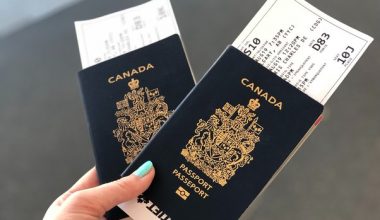Whenever we talk about anything immigration, the frequent questions we get from readers are whether a student visa and an immigrant visa is the same thing. In student visa vs immigration visa comparison, it is very important you know where the difference lies, especially for those desiring to migrate to European nations.
In this article, we shall present a comprehensive rundown of all you need to know about student visa and immigration visas. We shall also answer the frequently asked questions about student visa vs immigrant visa.
Let us not also forget to tell you that you are in the right place because our team has linked up with industry experts and top research associates to ensure you get to know all you should about student visa and immigration visa
What is Immigrant visa?
United States Authorities grant an immigrant visa to a foreign national who wishes to live and work in the United States permanently. In most situations, the individual is sponsored by a relative or employer who applies with US Citizenship and Immigration Services (USCIS).
Certain candidates, such as highly skilled professionals, investors, and special immigrants, can file a petition on their own behalf. They then forwarded the application to the appropriate US Consulate or Embassy abroad for further processing and, if suitable, issuance of an immigrant visa to the prospective immigrant.
Before the immigrant visa expires, the intended immigrant must show the immigrant visa at a U.S. port-of-entry. Once the immigrant visa and associated documentation are evaluated and authorized by a CBP Officer, the intending immigrant becomes a lawful permanent resident.
Consult the USCIS or the Department of State websites for more information on immigrant visa classifications and requirements.
What Is a Student Visa?
We have figured out what an immigration visa is above, but is student visa an immigration visa? if it is not an immigration visa, what is a student visa? A student visa is a special endorsement that is appended to a government passport that is provided to students who are enrolled in approved educational institutions.
Student visas are non-immigrant visas that do not require the holder to become a citizen of the country in which they are issued. Any student who wishes to pursue higher education in another country must first get a student visa from the country in question.
To allow international students to attend school within their borders, most countries will issue student visas. In most situations, however, the student must first enroll in a post-secondary educational institution. So, for example, if you’re from another nation and want to study in the United States, you’ll need both visas.
Related Article: Easy Step by Step Procedure to Get a J-1 Student Visa
What type of Visa is a Student Visa?
When pairing student visa vs immigrant visa, one difference that stands out is the category student visa belongs. Student visa is a non-immigrant visa that grants the holder a student status in the United states. Upon completion of studies, the person will return back to his or her home country.
It does not give you the status of a migrant neither can you work with a student visa.
What are the types of student visa?
They may grant anyone planning to study in the United States one of the three international student visa types: F1 Visa, J1 Visa, or M1 Visa. “What visa do you need to work as an international student in the United States?” you might wonder.
The F1 and J1 visas provide you with the option of working, but they don’t guarantee it. The M1 Visa, on the other hand, does not allow for employment. Is student visa an immigrant visa you might wonder? We’ve broken down each of these three types of foreign student visas so you can understand how they will affect your life in the United States.
F1 Visa Academic Studies
The “F” visa is intended for academic purposes. Students enrolled in an academic program or an English language program are granted an F1 visa. In the United States, F1 visas are by far the most frequent type of international student visa.
F1 students must maintain a full-time course load to maintain their designation. Part-time, on-campus employment is possible with F1 status (fewer than 20 hours per week). Students can also work on optional practical training (OPT) for up to a year after finishing their academic degrees.
We expect students to complete their studies on the I-20 form’s expiration date (Certificate of Eligibility for Nonimmigrant Student Status)
J1 Visa Practical Training
The United States grant students who need practical training that is not accessible in their home country to finish their academic program a J1 visa. As long as the exchange visitor program sponsor gives approval, J-1 student status allows for equivalent employment to those of an F1 visa, with identical restrictions.
M1 Visa Non-Academic / Vocational Studies
Students who wish to attend a non-academic or vocational school are granted an M1 visa. M-1 visa. Holders enrolled in technical programs are prohibited from working throughout their education. Applicants for M-1 student visas must show that they have adequate finances on hand to cover all tuition and living expenses for the duration of their proposed stay. In pairing student visa vs immigrant visa, students should understand proof of funds is very important for both.
What are the types of Immigrant visas?
Immediate relatives, family preference visas, diversity visas, and employment-based visas are among the types of immigrant visas foreign nationals can apply for. We have seen the definition of student visa but is student visa an immigrant visa? Read as we explain below.
Immigrant Visas for Immediate Relatives
Immigrant visas for immediate relatives who are U.S. citizens are available to foreign nationals. The amount of immediate relative visas awarded each year is unrestricted, unlike other immigration visas.
A spouse, unmarried kid under the age of 21, or parent is considered an immediate family member. For immediate relatives of U.S. citizens, the following visa classes are available:
Visas for Tourists or for Business
In comparing student visa vs immigrant visa students and individuals should know that under this tourist or business visa, there are two types of visas available. They are as follows:
- B-1 for business associates, people attending scientific, educational, or business conventions, estate settlement, or contract negotiations.
- B-2 can be used for pleasure or medical purposes. Tourism, visiting friends and family, medical care, and social or service activities are all examples of this.
The two types of visas are frequently combined and issued as a single document. You must show to the consular officer that your stay in the United States is temporary and that you have the finances to meet your expenses while there. Proof of residence outside the United States is also required. You are not permitted to work while on this visa.
Work Visa
To work temporarily in the United States, you’ll need a specific visa based on the type of work you’ll be doing. Applicants for the H, L, O, P and Q visas must have their petition accepted by USCIS on their behalf. Before filing for a work visa at the Consulate, Form I-129 must be granted.
The employer will then get Form I-797, which is the approval notification for your petition. You must bring I-129 and a copy of Form I-797 with you to the Consulate for your interview.
The following visas are available for work:
Specialty occupations (H1-B)
To be eligible for a H1-B visa, you must have a Bachelor’s degree in a specified specialty, and USCIS will decide whether your job qualifies as a specialized profession and whether you are qualified to provide the service. The employer must submit a labor condition application to the Department of Labor detailing the terms and conditions of your employment contract.
H-1 B-1 — Work Visa for a Limited Time
Singaporean and Chilean citizens can apply for a temporary work visa in the United States. Individuals must, however, have an employment offer in the United States before applying for the visa.
Seasonal agricultural laborers are eligible for H-2A visas
This visa allows firms in the United States to hire foreign nationals to fill temporary agricultural jobs if American workers are not available. Your employer files the Form I-129 petition on your behalf. This visa is not available to Indians.
H-2B visas are available for both skilled and unskilled workers.
This visa is for those who are filling a temporary or seasonal job for which there is a labor shortage in the United States. This visa is not available to Indians. When pairing student visa vs immigrant visa H-2 remains a big difference between the two.
H-3 (trainees)
This is required if you are traveling to the United States to obtain training from an employer for up to two years in any field. You can be compensated for your training, but it cannot be used to generate income.
Dependents (H-4)
If you have a valid H Visa, your spouse and unmarried children under the age of 21 may apply for an H-4 Visa to accompany you to the United States. However, your spouse and children with this Visa are not allowed to work in the United States. When pairing for the difference between student visa vs immigrant visa, H-4 visa cannot substitute for a student visa.
Intra-company transfers are classified as L-1
If you are an employee of an international firm who is being transferred temporarily to the main branch, an affiliate, or a subsidiary of the company, you will need this Visa. To be eligible for this visa, you must be a manager or executive level employee with specialized experience in the position you would occupy in the United States.
L-2 Designated for Dependents.
If you have a valid L Visa, your spouse and unmarried children under the age of 21 may apply for an L-2 Visa to visit the United States. If your spouse intends to work in the United States, they must submit a completed Form I-765 along with the application cost. They will deny your children permission to work in the United States.
Visa Status O
Those with exceptional aptitude in science, education, the arts, business, or athletics, as well as outstanding achievement in motion picture and television production, are eligible for this type of visa.
Visa Type P
Athletes, entertainers, and important support employees who come to perform in the United States are eligible for this visa.
Visa Type Q
This Visa is necessary if you are traveling to the United States to take part in an international cultural exchange program for the aim of giving training, employment, and sharing your home country’s history, culture, and traditions. The sponsor must file the petition, which must be allowed by USCIS.
Related Article: How to Renew Student Visa in America
Is Student Visa an immigrant visa? Differences and Similarities
A student visa is not the same as an immigrant visa. Their differences set them apart. While student visa are issued to students that wish to study in the United States, the issue immigrant visas to individuals to settle down to work in the United States.
To throw more light on what we mean, below are similarities between a student visa and an immigration visa.
Student Visa vs Immigrant Visa (similarities)
- In pairing a student visa vs immigrant visa side by side, you will have to understand that the United States Embassy issued both.
- Both visas are subject to renewal.
- Holders of both visas can work. However, certain requirements will have to be fulfilled for such to take place.
- They hold a recognizable status in the country issued.
- They can switch student visa and immigration visa to the forms of visa.
Student Visa vs Immigrant Visa (Differences)
We have seen the similarities between student visa and immigration visa above, but, is a student visa an immigration visa? The clarity of the issue would be seen more in the differences, as stated below.
| Student Visa | Immigrant Visa |
| Student visa is only for study purposes | Immigrant visa is mainly for work and permanent residence purposes |
| Student visa can only be obtained through a formal application process | Immigrant Visa can be obtained through visa lotteries |
| Dependants cannot join student visa holders. | Dependants can join immigrant visa holder. |
| Takes a shorter time frame | Takes a very lengthy process |
We note a good number of factors while pairing student visa vs immigrant visa. The differences we stated above clearly detail and answer those asking is student visa an immigrant visa?
What is the Difference between Student visa and an Immigrant Visa?
The United States government grants foreign-born individuals who desire to make an immigrant visa. Permanent resident, immigrant, green card holder, and resident alien are all synonyms for immigrant visa. Immigrants have most of the same privileges and rights as U.S. citizens, including the ability to work and live in the United States.
Student Visa, on the other hand, is in the category of non-immigrant visa. A student visa is a special endorsement that is appended to a government passport that is provided to students enrolled in approved educational institutions.
Student visas are non-immigrant visas that do not require the holder to become a citizen of the country in which they issued it. Any student who wishes to pursue higher education in another country must first get a student visa from the country in question.
Related Article: How To Change Your Student Visa To Green card
What is the Difference Between Immigrant Visa and Non-Immigrant Visa?
In the United States, there are distinct differences between immigrant and nonimmigrant visas. In summary, the US offers an immigrant visa to persons who want to work and live permanently in the country, whereas a nonimmigrant visa is issued to people who are visiting the country for tourist, medical treatment, temporary work, school, or other reasons.
Immigrant Visa
The US government grants foreign-born individuals who desire to make an immigrant visa. Permanent resident, immigrant, green card holder, and resident alien are all synonyms for an immigrant visa. Immigrants have the same rights and privileges as citizens in the United States, including the ability to work and live in the country.
A family member or an employer in the United States sponsors most people to get an immigrant visa. Others may become permanent residents because of refugee or asylum status, as well as other humanitarian programs.
Getting immigrant status can be a long and difficult process, depending on the path taken.
Non-immigrant Visa
The US government grants other foreign-born individuals a nonimmigrant visa for a temporary visit to the US. A nonimmigrant visa usually requires the bearer to leave the United States within a particular time frame. The visit could be for tourism, business, temporary work, or school.
Once a person has been granted nonimmigrant status in the United States, they are limited to the activity or cause for which it admitted them. To stay within the requirements of a student visa, for example, the student must remain enrolled in school.
The majority of nonimmigrant visas are only granted to applicants who can show they intend to return to their home country.
What are the Requirements for Immigrant and Nonimmigrant Visas?
- Someone must usually sponsor you or file an immigrant petition on your behalf.
- Wait until your petition is approved and a visa in your category becomes available.
- After that, apply for an immigrant visa.
- Obtain a medical evaluation.
- Attend a job interview.
- Await a response to your application.
Requirements for Nonimmigrant Visas
- Non-immigrant DS-160 application form is available online. Here is where you can submit the DS-160 form.
- One photograph.
- Your valid passport.
- Receipt confirming payment of $160 for a nonimmigrant visa application in the United States.
- Your social media details.
The above details to a large extent the discrepancy while pairing student visa vs immigrant visa.
Related Article: Canada Visa Lottery Scam or Legit? See What Works for Immigrants
Points to Remember When Applying for a Student Visa
1. Develop a strategic plan
Make an appointment to have your application assessed at the embassy or consulate. Summer and winter vacations are typically busy times, so planning ahead of time to guarantee you obtain an appointment when you need one may be necessary.
2. Prepare your documents
Copies of your application, receipts for the visa application fee payment, and receipts for the Student and Exchange Visitor Information System (SEVIS) fee payment are all required documents for your US student visa application. Make sure you have a valid passport as well as supporting documents, like your school admission letter and transcripts.
3. Affirm your intention of returning home.
Prepare to show that you have no intention of breaking the US immigration law. Non-immigrant visa applications are scrutinized under US law, and candidates must show that they have substantial ties to their home countries and are not simply exploiting the student visa to enter the country. Family ties, financial interests, and work can all be used to show ties to your home country.
4. Be clear about your goals.
Demonstrate that you know and care about the academic or occupational program to which you’ve been accepted, as well as how it fits into your long-term professional goals. Your ability to articulate the link between school and career is crucial in persuading the consular official that your intention is to study in the United States rather than immigrate.
5. Put your English language skills to the test.
Practice your English speaking abilities so you can give the consular officer precise and straightforward information. Your ability to speak successfully with officials will aid in the approval of your student visa application.
Points to Remember When Applying for an Immigrant Visa
While placing student visa vs immigrant visa, we equally have to figure out the points to always remember when applying for these types of visas.
- You must have a sponsor based in the United States.
- Be ready to pay some non-refundable visa fees.
- Present a clear, concise plan on why you want to migrate to the united states.
- Must be in sound health of mind and body.
- Be sure you have no criminal background.
- Proof of funds as well as evidence of employment in the case of employment visa.
Frequently Asked Questions
International students are “non-immigrant” tourists who travel to the United States for a limited time to attend classes or to take online courses from anywhere around the globe.
Before traveling to Canada, apply for an immigrant visa. A study permit is not the same as a visa. It prevents you from entering Canada. A visiting visa or an electronic Travel Authorization may also be required (eTA)
An F1 visa is a nonimmigrant visa that allows students to study in the United States. If you want to study at a university or college, high school, private elementary school, seminary, conservatory, language training program, or other academic institution in the United States, you must apply for an F1 visa.
Conclusion
In student visa vs immigrant visa comparisons, a lot comes to play, which we have outlined above. They have their similarities and differences. All of them, however, still ensure you get accepted to enter the United States or any country for certain specific purposes.
Subscribe to our newsletter here for subsequent updates on student and immigrant visa.
References
Recommendations
- How To Get a Student Visa In Italy | Step-To-Step Procedures
- How To Apply For a Student Visa In France | Interview, Requirements, Permit
- MBA In France: Top 5 Universities, Academic Requirements, Scholarships, Tuition, Student Visa
- How Long Does a Student Visa Last & How can I Renew?
- Easy Step by Step Procedures to get Singapore Student Visa
- How to Get Student Visa Sponsorship | Step-by-Step Procedures
- How To Get Student Accommodation In Sheffield
- Easy Step by Step Procedures to Get Poland Student VISA





